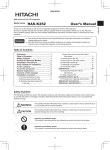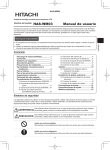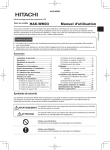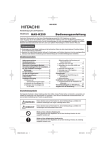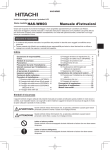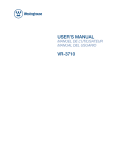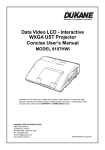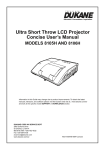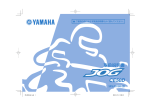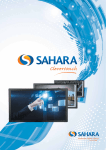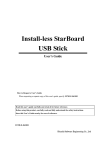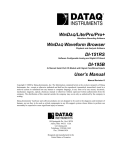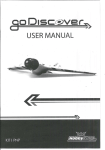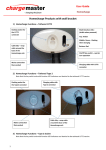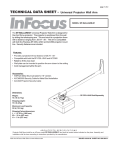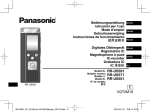Download LCD Data Video Projector User`s Manual
Transcript
LCD Data Video Projector User’s Manual Model 8104HW-WALLARM Information in this Guide may change due to product improvements. To obtain the latest manuals, literature, and software please visit the Dukane web site at; www.dukane.com/av and look at the specific model SUPPORT or DOWNLOADS section. DUKANE CORP AV SERVICE DEPT 2900 Dukane Drive St Charles, IL 60174 800-676-2487 / 630-762-4032 Fax 630-584-5156 [email protected] www.dukane.com/av 403-8104HW-WALLARM-Manual-00 HAS-K250 Wall mount unit for LCD projectors 8104HW 8104HW-WALLARM User’s Manual Thank you for purchasing a wall mount unit specially designed for Dukane LCD projectors. Be sure to read this manual and the User’s Manual supplied with the LCD projector before use so you will know how to install it properly. After you have finished reading these documents, put them away in a safe place for future reference. Disclaimer ENGLISH Model name ● The content of this manual and the specifications of the product it describes are subject to change without prior notice. ● Note that Dukane will accept no liability whatsoever for injuries and damages arising from incorrect use or handling that exceeds normal operating limits. Table of Contents Screen sizes when used with Hitachi Star Board ............................................ 9 Attaching the arm (M) ..............................12 Securing arm (M) using screws ...............12 Attaching bracket (B) ...............................12 Attaching LCD projector ..........................13 Connecting cables ...................................13 Disclaimer ................................................ 1 Table of Contents ..................................... 1 Safety Symbols ........................................ 1 Outline and Relevant Models .................. 2 Installation Precautions .......................... 2 Tools needed for installation .................. 2 To the customer ....................................... 3 To service personnel ............................... 3 Routine Inspections ................................ 3 Contents of this package ........................ 4 Installation procedure ............................. 5 Adjustments ............................................14 Displaying image for making adjustments .........................................14 Image adjustments ..................................15 Installing exterior parts ..........................18 Removing shipping screws ....................... 5 Removing base bracket (O) ...................... 6 Attaching the base bracket (O) to the wall ............................................. 7 Procedure for installing exterior parts .....18 Adjustment precautions ........................ 21 Adjustment specifications .................... 22 Safety Symbols The following symbols are used in this manual to help you use this product safely and correctly, and to prevent injury to yourself and others or damage to property. Read through the safety instructions below so you can operate the product correctly. WARNING This symbol indicates information that, if ignored, could result in serious personal injury or even death due to incorrect handling. CAUTION This symbol indicates information that, if ignored, could result in personal injury or physical damage due to incorrect handling. Indicates a prohibited action. This symbol is accompanied by text indicating an action that must not be taken. Indicates a mandatory action. This symbol is accompanied by text indicating an action that must be taken. 1 *#5-A'0)KPFF Outline and Relevant Models HAS-K250 This product is designed to mount a LCD projector on a wall. Supported Dukane LCD projector models: 8104HW CP-A220N(CP-A220NM) CP-A300N(CP-A300NME/G) ED-A220N(ED-A220NM) Installation Precautions Installation of this product requires special technical skills. Ask your dealer or service center (for details, see the User’s Manual supplied with the LCD projector) to handle the installation work. Be sure to observe the following instructions when installing an LCD projector. 1. Considerable care is required in planning and performing the installation so that it will support the weight of the LCD projector and wall mount unit. LCD projector Approx. 3.8 kg Wall mount unit (8104HW-WALLARM) Approx. 5.9 kg Approx. 5.9 kg 2. If the temperature inside the LCD projector gets too high, the temperature sensor will activate and turn off the projector to prevent damage. Do the following to avoid an abnormally high temperature. (1) Select a location where the ambient temperature is in the range of 5 to 35°C. (2) Periodically clean the projector’s air intake filter. For details on how often and how to clean the filter, see the LCD Projector User’s Manual. (3) In a dusty location, the filter will need more frequent cleaning than in (2) above so install the projector in a location where cleaning is easy. (4) Leave 30 cm or more space on the sides of the LCD projector to allow the free flow of air from the exhaust and leave 10 mm or more space at the back of the projector to enable air to enter via the air intake. (5) Do not install the projector in a location exposed to sudden temperature changes, for example near air conditioners, or where the temperature rises above 35°C. 3. Do not install the projector in a smoke-filled or extremely dusty environment as the tar in cigarette smoke will settle on the optics and lower performance. 4. Do not install the projector in a location where the remote control sensor will be exposed to direct sunlight, other strong light sources or inverter fluorescent lamp light at close range to prevent remote control malfunction. Tools needed for installation 136 (5.35) 25 (0.98) Unit: mm (inches) 125 (4.92) ● The wall mount unit must be secured using at least eight M10 anchor bolts. The bracket has 16 oval 11 × 33 mm (0.43 × 1.3 inch) mounting holes. Use anchor bolts of a length that suits the strength and thickness of the wall so that the pullout strength of each bolt meets or exceeds 2,000 N. If required, increase the number of anchor bolts. Mounting holes 11 × 33 oval holes (16 locations) (0.43 × 1.3) 2 *#5-A'0)KPFF HAS-K250 WARNING ■ Do not attempt to install the projector yourself. Have your dealer or service center handle all installation work. Note that will accept no liability whatsoever for accidents or injuries resulting from an incorrect installation or improper use. ■ Make sure that the projector is installed high enough so that there is no risk of people bumping their heads. If a sufficiently high installation cannot be made, be sure to take the necessary precautions when the projector is used. ENGLISH To the customer ■ Do not hang on the LCD projector or the arm after installation as this could cause the LCD projector to fall down or bend the arm resulting in injury or damage. ■ Do not install the projector in a location exposed to high humidity, dust or tobacco smoke or in a location exposed to smoke or steam. ■ Do not install the projector in a location exposed to vibrations. ■ After you have finished installation, keep this manual and accessories in a safe place for future reference. ■ Small parts such as screw caps and adjusting knobs could be swallowed by children and pets and should be kept out of their reach. If your child swallows any small parts, consult a doctor immediately. To service personnel ■ Perform all installation work correctly according to this manual. Make sure that all specified screws and brackets are used in the installation. ■ Considerable care is required in planning and performing the installation so that it will support the weight of the LCD projector and wall mount unit. ■ Never attempt to modify the wall mount unit. (We will not guarantee the strength of a unit that has been modified.) ■ Make sure that all screws are tightened to the proper torque after installation and adjustments. There must be no loose or over tightened screws. ■ Do not use adhesives, lubricants, lubricating oils or other chemicals designed to prevent loosening of fasteners on screws and bolts used to secure the projector ceiling mount. The use of such materials could cause the mount to fail and the projector to fall resulting in damage or injury. ■ Route electric cables as prescribed and take care not to damage them in the installation work. ■ Be sure to read this manual and the User’s Manual of the LCD projector prior to installation to ensure that all safety instructions are observed and the projector is correctly installed. ■ Be sure to turn off the LCD projector and disconnect the power plug from the wall outlet before starting installation work. Routine Inspections Like the projector, the wall mount unit should be inspected once a year. 1. Check that the screws in the wall mount unit and adjusted parts are not loose. 2. Check that the wall mount unit, adjusted parts and the set are not scarred or damaged. 3 *#5-A'0)KPFF HAS-K250 Contents of this package Check that the items listed in the table below are included in this package. If any are missing, please contact your dealer immediately. (The fasteners (screws, etc.) required for wall mounting are not supplied with the wall mount unit. Select fasteners that suit the structure of the wall to ensure they will properly support the LCD projector and the wall mount unit.) Part names in the figures on the following pages are indicated by the symbols given in the table below. Symbol Part name Quantity Appearance Symbol Part name Quantity A Arm assembly 1 G M4 × 8 hexagon head screws 4 B Bracket 1 H M4 × 8 round head screws 4 C Front cap 1 I Allen wrench 1 Appearance Front end dimensions Diameter 5 Diagonal measurement (5.8) Screen Center Wall Plate Center 16:10 Screen Surface 42.5 136 25 11 33 125 Screen Size 60inch b 120mm (4.7inch) Template sheet b 1 h 16:10 Top Line Screen Size h Screen Size h 100inch 392mm (15.4inch) 60inch 208.3mm (8.2inch) 63inch(4:3) 250.3mm (9.9inch) 90inch 88inch 324mm 310mm (12.2inch) (12.8inch) J 83inch(16:9) 77inch(4:3) 292mm 305mm (11.5inch) (12.0inch) 8 80inch 256mm (10.1inch) Screw caps 70inch 63inch(4:3) 188mm 197mm (7.4inch) (7.8inch) D 70inch 245.3mm (9.7inch) 80inch 282.3mm (11.1inch) 77inch(4:3) 309.3mm (12.2inch) 88inch 312.3mm (12.3inch) 90inch 320.3mm (12.6inch) 83inch(16:9) 360.0mm (14.2inch) 100inch 357.3mm (14.1inch) QT54601 E Arm cover 1 F Adjust cover 1 K User’s Manual (This book) 1 4 *#5-A'0)KPFF HAS-K250 Installation procedure Remove the shipping screws from the arm assembly (A). Shipping screw (M5 screw with spring washer and flat washer) ENGLISH The arm assembly (A) is assembled before shipping. Before attaching the arm assembly to a wall, remove the two shipping screws (M5 screws with spring washer and flat washer) as shown in the figure below. Shipping screw (M5 screw with spring washer and flat washer) 5 *#5-A'0)KPFF HAS-K250 Remove the base bracket (O) from the arm assembly (A). Before attaching the arm assembly to a wall, remove the screws to disassemble it as shown in the figure below. Before disassembly, place the arm assembly on a mat or the protective plastic it was shipped in to prevent damaging the floor or the bracket. (L) M5 shoulder screws (3) (L) (P) (P) (L) (O) Base bracket (N) (L) (P) M5 screw with spring washer and flat washer (M) Arm Note: The groove in the base bracket (O) is engaged with the tab at the rear of the arm (M). Move the base bracket away from the arm and then downward to remove it. Tab (rear of arm) Tab (M) Arm (O) Base bracket * Part names in the figures on the following pages are indicated by the symbols given in the ( ) brackets. 6 *#5-A'0)KPFF HAS-K250 Attach the base bracket (O) to a wall using the anchor bolts (M10). (O) ■ Use anchor bolts to attach the base bracket (O) to a wall. ■ Use M10 anchor bolts. ■ Use anchor bolts of a length that suits the material, strength and thickness of the wall so that the pullout strength of each bolt meets or exceeds 2,000 N. ■ If the bolts cannot satisfy the required strength specifications, increase the number bolts. ENGLISH The holes in the base bracket (O) are oval to permit horizontal adjustment. For details on the length and number of the anchor bolts (M10) that are required, see “Tools needed for installation” on page 2. Anchor bolt M10 anchor bolts (8 or more) Base bracket (O) Concrete WARNING ■ When attaching the wall mount unit to a wall covered with a layer of plaster or other weak finishing material, make sure the anchor bolts reach into the underlying concrete. Weak material Weak material Anchor bolt Concrete Anchor bolt Concrete ■ As shown in the figure, at least eight anchor bolts, two in each corner are required. 7 *#5-A'0)KPFF Base bracket attachment diagram HAS-K250 Note: The wall hole center is 42.5 mm (1.67 inches) to the right of the screen center. Unit: mm (inches) Unit: mm (inches) Wall hole center 85 (3,35) 195 c1 c4 240 30 30 (1,18) 125 (4,92) 136 (5,35) (1,18) 42,5 (1,67) Amount of vertical adjustment 32 (1,26) Screen center c3 b c2 Screen Screencenter center a (*1) Screen thickness 16:10 screen (8104HW) (Full screen: Reference value for 1,280 × 800 pixel image.) a b c1 c2 c3 c4 Diagonal size (inches) 60 70 80 90 100 mm (inches) 120 (4,7) 188 (7,4) 256 (10,1) 324 (12,8) 392 (15,4) mm (inches) 295 (11,6) 332 (13,1) 369 (14,5) 407 (16,0) 444 (17,5) mm (inches) 1102 (43,4) 1274 (50,2) 1446 (56,9) 1618 (63,7) 1791 (70,5) mm (inches) 202 (8,0) 239 (9,4) 276 (10,9) 314 (12,4) 351 (13,8) mm (inches) 410(16.1) 447(17.6) 484(19.1) 522(20.1) 559(22.0) 8 2010/11/03 16:00:00 HAS-K250 4:3 screen (Full screen: Reference value for 1,024 × 768 pixel image.) a b c1 c2 c3 c4 Diagonal size (inches) 60 70 80 90 100 mm (inches) 96 (3,8) 161 (6,3) 225 (8,9) 289 (11,4) 353 (13,9) mm (inches) 281 (11,1) 317 (12,5) 352 (13,9) 387 (15,2) 423 (16,7) mm (inches) 1196 (47,1) 1384 (54,5) 1571 (61,9) 1759 (69,3) 1947 (76,7) mm (inches) 188 (7,4) 224 (8,8) 259 (10,2) 294 (11,6) 330 (13,0) mm (inches) 396(15.6) 432(17.0) 467(18.4) 502(19.8) 538(21.2) ENGLISH (Future models) (*1) For a 50 mm thick screen Size of images that can be projected with screen sizes of up to 100 inches. * Use of the supplied template sheet will facilitate positioning of the base bracket. Note: Note that projection distance b will vary by ±8% depending on what product is used. Screen sizes when used with Hitachi Star Board 8104HW (WXGA) Modell Hitachi Star Board FX-82WG Unit: mm (inches) Aspect ratio 16:9 Projection size Diagonal Dimensions size (inches) b c1 1.831 × 1.030 292 (72,1 × 40,6) (11,5) 83 447 (17,6) c2 c3 c4 1.480 354 562 (58,3) (13,9) (22,1) (*1) Hitachi Star Board FX-DUO-88W Hitachi Star Board FX-TRIO-88W 16:10 1.896 × 1.185 310 (74,7 × 46,5) (12,2) 88 514 399 1.584 306 (15,7) (62,4) (12,0) (20,2) (*1): Sizes for a 16:9 aspect ratio setting. CFuture models (XGA) Modell Unit: mm (inches) Projection size Diagonal Aspect Dimensions size ratio (inches) b c1 c2 c3 c4 Hitachi Star Board FX-63G Hitachi Star Board FX-DUO-63 4:3 63 1.280 × 960 (50,4 × 37,8) 116 (4,6) 292 (11,5) 1.252 199 (49,3) (7,8) 452 (17,8) Hitachi Star Board FX-77G Hitachi Star Board FX-DUO-77 Hitachi Star Board FX-TRIO-77 4:3 77 1.565 × 1.173 (61,6 × 46,2) 206 (8,1) 341 (13,4) 1.515 248 (59,6) (9,8) 511 (20,1) (*2) (*2): Sizes for a 4:3 aspect ratio setting. 9 2010/11/03 16:00:00 HAS-K250 Template sheet usage Determining location of wall holes Place the template sheet (J) where you want to project the image. Vertical orientation: Align the top of the sheet with the upper edge of the image you want to project. Horizontal orientation: Align with the screen center. Note: The base bracket center is 42.5 mm (1.67 inches) to the right of the screen center. Make a hole in the wall as indicated by the base bracket figure. 136 25 8104HW Screen Size b (WXGA 16:10) 11 33 63inch 116mm (4.6inch) 60inch 120mm (4.7inch) 125 Other Models 60inch Screen Size b 96mm CP-A300N (XGA 4:3) (3.8inch) ED-A220N Wall Plate Center 42.5 Screen Surface Screen Center 70inch 161mm (6.3inch) 70inch 188mm (7.4inch) 77inch 80inch 206mm 225mm (8.1inch) (8.9inch) 80inch 256mm (10.1inch) b 63inch 199mm (7.8inch) 70inch 224mm (8.8inch) 70inch 239mm (9.4inch) 100inch 392mm (15.4inch) 60inch 202mm (8.0inch) 100inch 353mm (13.9inch) 60inch 188mm (7.4inch) 8104HW 90inch 324mm (12.8inch) Other models CP-A300N ED-A220N Screen Size h (WXGA 16:10) 90inch 289mm (11.4inch) Screen Size h (XGA 4:3) 88inch 310mm (12.2inch) 16:10 Top Line 4: 3 83inch 292mm (11.5inch) h 77inch 248mm (9.8inch) 80inch 276mm (10.9inch) 80inch 259mm (10.2inch) 88inch 306mm (12.1inch) 90inch 314mm (12.4inch) 100inch 351mm (13.8inch) 90inch 294mm (11.6inch) 100inch 330mm (13.0inch) 83inch(16:9) 354mm (13.9inch) QT54602 10 2010/11/03 16:00:00 HAS-K250 Adjusting arm length 136 25 Projection distance for 16:10 screen Projection distance for 4:3 screen 63inch 116mm (4.6inch) 60inch 120mm (4.7inch) 125 60inch 96mm (3.8inch) CP-AW250N Screen Size b (WXGA 16:10) 11 33 CP-A220N Screen Size b CP-A300N (XGA 4:3) ED-A220N Wall Plate Center 42.5 Screen Surface Screen Center ENGLISH Arrows at the right and left sides of the template sheet (J) indicate the distance from the screen surface to the back of the projector. During rough adjustments of arm length, adjust it according to the dimension of distance from the screen surface to the back of the projector. 70inch 161mm (6.3inch) 70inch 188mm (7.4inch) 77inch 80inch 206mm 225mm (8.1inch) (8.9inch) 80inch 256mm (10.1inch) b 63inch 199mm (7.8inch) 70inch 224mm (8.8inch) 70inch 239mm (9.4inch) 100inch 392mm (15.4inch) 60inch 202mm (8.0inch) 100inch 353mm (13.9inch) 60inch 188mm (7.4inch) 8104HW 90inch 324mm (12.8inch) CP-A220N CP-A300N ED-A220N Screen Size h (WXGA 16:10) 88inch 310mm (12.2inch) Screen Size h (XGA 4:3) 90inch 289mm (11.4inch) 83inch 292mm (11.5inch) h 16:10 Top Line 4: 3 77inch 248mm (9.8inch) 80inch 276mm (10.9inch) 80inch 259mm (10.2inch) 88inch 306mm (12.1inch) 90inch 314mm (12.4inch) 100inch 351mm (13.8inch) 90inch 294mm (11.6inch) 100inch 330mm (13.0inch) 83inch(16:9) 354mm (13.9inch) QT54602 Example 125 25 Screen Center CP-AW250N Screen Size h (WXGA 16:10) 60inch 202mm (8.0inch) 70inch 239mm (9.4inch) 80inch 276mm (10.9inch) 88inch 306mm (12.1inch) 90inch 314mm (12.4inch) 100inch 351mm (13.8inch) 83inch(16:9) 354mm (13.9inch) As shown in the figure, place the template sheet (J) on the wall like a screen to determine the required screen size and the distance from the wall to the back of the projector. 42.5 136 b Wall Plate Center 16:10 Top Line 4: 3 33 Screen surface h Screen Size h (XGA 4:3) 83inch 292mm (11.5inch) CP-AW250N 60inch 120mm (4.7inch) Screen Size b (WXGA 16:10) CP-A220N Screen Size b CP-A300N (XGA 4:3) ED-A220N 60inch 96mm (3.8inch) 63inch 116mm (4.6inch) 70inch 188mm (7.4inch) 70inch 161mm (6.3inch) 80inch 256mm (10.1inch) 77inch 80inch 206mm 225mm (8.1inch) (8.9inch) 88inch 310mm (12.2inch) 90inch 289mm (11.4inch) 90inch 324mm (12.8inch) 100inch 353mm (13.9inch) 100inch 392mm (15.4inch) QT54602 Screen Surface 60inch 188mm (7.4inch) CP-A220N CP-A300N ED-A220N 63inch 199mm (7.8inch) 70inch 224mm (8.8inch) 77inch 248mm (9.8inch) 80inch 259mm (10.2inch) 90inch 294mm (11.6inch) 100inch 330mm (13.0inch) 11 11 2010/11/03 16:00:00 HAS-K250 Attach the arm (M) to the base bracket (O). Insert the tab at the top of the arm (M) in the groove at the top of the base bracket (O). Then insert the U-groove at the bottom of the arm (M) in the groove of the vertical adjusting nut in the base bracket. Place the tabs (rear of arm) in the grooves. (M) (O) Note: Route the cables through this hole before attaching the arm (M) to the base bracket (O). Note: Insert the vertical adjusting nut as shown in the figure. Use three M5 shoulder screws (L), three washers (P) and one M5 screw with spring washer and flat washer (N) to secure. Tightening torque: 0.98 N•m (10 kgf•cm) Note: Be sure not to mix up the screw types. (L) (P) (L) (L) × 3 (P) (P) (L) (N) (N) × 1 Attach the bracket (B) to the LCD projector using four M4 × 8 (G) hexagon head screws. Tightening torque: 0.98 N•m (10 kgf•cm) Note: Make sure that the bracket (B) is correctly oriented. Projection direction Projection direction Projection direction Projection direction (G) (B) WARNING ■ Never use screws other than those designated. Failure to heed this warning may cause the projector to fall or other hazard resulting in damage or injury. 12 *#5-A'0)KPFF HAS-K250 Attach the LCD projector to which the bracket (B) has been attached to the adjusting block (Q). Tighten the four M4 x 8 round head screws (H). Tightening torque: 0.98 N•m (10 kgf•cm) (B) (B) (LCD projector front panel) (H) (H) ENGLISH (Q) (Q) (LCD projector rear panel) WARNING ■ Never use screws other than those designated. Failure to heed this warning may cause the projector to fall or other hazard resulting in damage or injury. Connect the cables to the projector. Connect as shown in the above figure. 13 *#5-A'0)KPFF HAS-K250 Adjustments Turn the projector on and project an image to make adjustments. -1. Project an image, adjust the image settings and focus on the LCD projector. • Adjust the focus. • Select MIRROR. • Set the D-ZOOM to its maximum value (full screen). • Reset PERFECT FIT. • Set the KEYSTONE and KEYSTONE values to 0. * For details, see to the User’s Manual for the LCD projector. -2. Use the remote control to select a screen for making adjustments. To simplify adjustments, press the Menu button on the remote control. The EASY MENU or ADVANCED MENU appears. MENU POSITION Menu button ENTER RESET ESC EASY MENU Go to step if the ADVANCED MENU appears. If the EASY MENU appears, use the cursor buttons (▲/▼) to select the ADVANCED MENU. ADVANCED MENU MENU POSITION Cursor button ENTER RESET ESC Use the cursor buttons (▲/▼) to select SCREEN. Use the cursor buttons (▲/▼) to select DOT-LINE4 in TEMPLATE. Then press the ENTER button to display the DOT-LINE4 screen. TEMPLATE MENU POSITION ENTER button ENTER ESC RESET DOT-LINE4 screen 14 *#5-A'0)KPFF HAS-K250 Adjust the image. -1. Loosen the securing screws. ENGLISH (at the eight locations indicated by the arrows in the figure below) -2. Rough adjustment of image size. Note: Do not loosen the screw on the right and the two screws on the opposite side. 1. Loosen the screw on the side of the arm. 2. Slide the arm forward and backward to adjust image size. The scale on the supplied template sheet (J) simplifies adjustment. See page 10 for information on how to use the template sheet. 3. After completing adjustments, retighten the screw. Tightening torque: 0.98 N•m (10 kgf•cm) A B * Use the supplied template sheet to simplify adjustment. (See page 10.) 15 *#5-A'0)KPFF HAS-K250 -3. Make a rough focus adjustment. For details, see the User’s Manual for the LCD projector. -4. Make fine adjustments. Follow the steps below to turn the adjusting screws and adjusting knobs to adjust the image. 5 3 1 2 4 1. Fine adjustment of horizontal position 2. Fine adjustment of horizontal keystone 3. Fine adjustment of vertical keystone 4. Fine adjustment of lateral position 5. Fine adjustment of image size 6. Fine adjustment of focus For details, see the User’s Manual for the LCD projector. 16 *#5-A'0)KPFF HAS-K250 7. Fine adjustment of vertical position Note: Do not loosen these three screws. ENGLISH 1. Loosen the screw on on the lower right side. 2. Turn the height adjusting screw to adjust the height. 3. After completing adjustments, retighten the loosened screw. Tightening torque: 0.98 N•m (10 kgf•cm) A A B Supplied Allen wrench (I) B • Repeat steps 1 to 7 to fine adjust the image to the screen. See page 22 for details on adjustment range. -5. Retighten the eight previously loosened securing screws. Tightening torque: 0.98 N•m (10 kgf•cm) 17 *#5-A'0)KPFF HAS-K250 Installing exterior parts Procedure for installing exterior parts -1. The knobs indicated by the arrows can be removed. Place them on the projections inside the front cap (C) for storage. (C) Adjusting knobs WARNING ■ Adjusting knobs are small parts that could be swallowed by children and pets and should be kept out of their reach. If your child swallows an adjusting knob, consult a doctor immediately. If they are removed, be sure to store them on the projections inside the front cap (C). 18 *#5-A'0)KPFF HAS-K250 -2. Attach the front cap (C) at the front end of the arm (M). Engage the left, right and center claws. ENGLISH The adjusting knobs can be removed. Place them on the projections inside the front cap (C) for storage. (C) Adjusting knobs -3.Attach the adjust cover (F) on the adjusting block. As shown in the figure, engage the right claw with the opening in the adjusting block. -4. Attach the eight screw caps (D) on the screws on the arm (M). Four locations on the right and left side Press in the caps until they are properly seated. 19 *#5-A'0)KPFF HAS-K250 -5.Attach the arm cover (E) to the arm (M). Insert the eight claws in the arm cover (E) in the eight holes in the arm (M). Note: When the arm (M) will be used in retracted mode, insert the claws at the four locations shown in the figure. -6. Assemble the cable cover as shown in the figure below. Note: The cable cover is supplied with the LCD projector. -7. Attach the cable cover. Engage the three tabs in the cable cover with the three holes in the LCD projector. Route the cables through the holes in the top of the cable cover. 3 3 2 1 2 1 20 *#5-A'0)KPFF HAS-K250 • Roll down screens and other screens that are not perfectly flat tend to substantially distort the projection surface and cannot be used. Use board screens or other flat screens. Bead-type screens with a high screen gain are not suitable for this projector. Use of a matte screen with a wide viewing angle and a gain of about 1.0 is recommended. Interaction between the screen pattern and LCD pixels may result in interference fringes (moiré). This is not a malfunction. Use a screen that suppresses this phenomenon. • The size of the image at the top of the screen changes with focus adjustment. Fine-tune screen position and angle after adjusting focus the first time. • Reset corner fit before starting adjustments. • Make sure that the digital zoom value is set to the maximum value (full screen) before starting adjustments. • Make sure that the keystone control is set to 0 (no correction) before starting adjustments. • It takes about 30 minutes for lamp performance to stabilize and a change in environment may cause subtle changes in projection location and focus. Make proper adjustments to compensate for changes in focus. ENGLISH Adjustment precautions Note: • Changes in temperature, humidity and other ambient environmental factors may result in changes in screen size and location. • The minute vibrations and other phenomena that the wall mount unit and the mirror are exposed to will start to cause changes in projection location a week or so after installation. 1. • Set a screen size that is smaller relative to actual screen size to allow for changes after installation. • Use the values in the table below to set a vertical and lateral margin. • Set a margin for each corner to allow for screen distortion. Vertical margin (both 4:3 and 16:10 screens) Screen size Diagonal size (inches) 60 80 100 Vertical margin (mm) 20 25 30 Lateral margin (mm) 25 30 35 Lateral margin Projected image Lateral margin Vertical margin 21 *#5-A'0)KPFF HAS-K250 Adjustment specifications ● LCD projector range of motion provided by arm extension/contraction (See page 21 for adjusting procedure.) ±30 mm (1.18 inches) ±30 mm (1.18 inches) Fine adjustment amount of vertical position (See page 17 for adjusting procedure.) 369 mm (14.53 inches) Item Image movement Fine adjustment amount (amount of LCD projector movement) Description of adjustment method Fine adjustment of horizontal position ±3° page 16 Fine adjustment of horizontal keystone ±3° page 16 Fine adjustment of vertical keystone ±3° page 16 Fine adjustment of lateral position ±20 mm (0.79 inches) page 16 Fine adjustment of image size ±20 mm (0.79 inches) page 16 Fine adjustment of vertical position ±30 mm (1.18 inches) page 17 DUKANE CORP AV SERVICE DEPT 2900 Dukane Drive St Charles, IL 60174 800-676-2487 / 630-762-4032 Fax 630-584-5156 [email protected] www.dukane.com/av 22 *#5-A'0)KPFF
























